Types of Brown Spiders (with Pictures) – Identification Guide

Seeing a brown spider scurrying along the floor can be terrifying. Some brown house spiders have large dark brown bodies with long spindly legs. You might find other types of scary brown furry spiders that look like tarantulas in a basement, attic, or an outbuilding; however, they are usually completely harmless. But, of course, a large brown recluse spider can lurk in crevices and inflict a nasty bite if you get too close.
If you spot a brown-looking spider indoors, you will probably ask yourself, “what is this brown spider in my house?” First, it’s vital to identify the type of brown spider. Although most brown and black spiders are harmless, a few species are dangerous. This means that you must take care if trying to get rid of any type of spider.
For example, a furry brown spider with black stripes on its legs can jump. There is also a brown spider with white spots on its back and a big round body with a venomous bite. Or you may find a yellow and brown spider in your garden spinning an orb web. Other types of little brown spiders look like black widows and have a painful bite and live behind messy webs.
This article is a guide to identifying common types of brown spiders you may find in your home. Descriptions and pictures of brown-colored spiders will also help you identify a dangerous spider from a harmless one.
Facts About Brown Spiders
Most people think about the brown recluse spider when they think about harmful brown spiders. The brown recluse has a light brown body with a dark brown marking on its back. Although these brown spiders bite, they tend to hide away and avoid people.
In the home, you are more likely to come across common types of harmless brown house spiders. For example, there is the cupboard spider, American house spider, cellar spider, and the aggressive house spider. While most spiders bite, brown spiders are not considered dangerous but rather a nuisance pest.
Like all spiders, brown spiders are eight-legged creatures in the class Arachnida. However, it’s good to remember that spiders aren’t insects.
How to Identify Brown Spiders
You can identify a brown spider by looking at its body shape, coloration, patterns, size of legs, and if it is smooth or hairy. In addition, spiders have identifiable two body parts, fused head and thorax (cephalothorax) and abdomen. Another identification feature is that spiders have eight legs, not six.
Unlike insects, spiders don’t have any antennae or wings. Also, spiders can have up to 12 eyes; however, most have four or eight eyes.
Another way to identify spiders is by the type of webs they spin. For example, brown cellar spiders spin messy webs. On the other hand, some spiders create intricate orb webs, which are the characteristic spider webs. Spiders are also identified by their habits and habitat.
Types of Brown Spiders (With Pictures) – Identification Guide
Let’s look at common types of brown spiders to learn how to identify the scurrying eight-legged arthropods.
Brown Recluse Spider (Loxosceles reclusa)
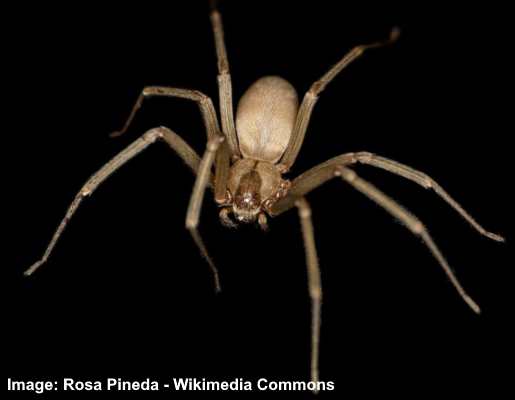
The brown recluse is a venomous spider with light brown body and long legs
The brown recluse is a biting spider with a bulbous, light brown oval abdomen, eight legs, and a furry-looking body. The identifying feature of the brown recluse is its marking in the shape of a violin on the front part of its light brown body. Additionally, it’s one of the few spiders with six eyes.
The brown recluse spider is also called a brown fiddler, fiddleback spider, or violin spider. But it’s important to remember that other brown spiders also have a distinctive violin-like pattern on their backs.
Adult brown recluse spiders typically measure between 0.24” and 0.8” (6 – 20 mm). In comparison to its body, the venomous brown spider has long legs extending out in a star shape.
To keep a brown recluse out of your house, seal up all cracks and openings in your home’s foundation. Also, bug screens and floor sweeps can help prevent brown recluses from getting into your house. It is also wise to remove all unnecessary clutter from attics, basements, and closets.
Brown recluse spiders like to hide in quiet, dark corners in basements, cupboards, closets, attics, and boxes. Therefore, when moving items in these places, it’s best to wear gloves to prevent brown recluse bites. A brown recluse spider bite can be like a black widow bite and cause pain, fever, localized redness, and swelling.
Always seek medical attention if you suspect a brown recluse bite.
Brown Spider Identification: Identify a brown recluse spider by its yellowish-brown body and violin-shaped dark brown marking on its rounded, elongated front part. This brown spider has six eyes and long legs.
Brown House Spiders
There are many types of tiny brown spiders commonly found in homes. The small spiders can have light brown bodies with black or dark brown spots. Other species of house spiders have shiny bulbous abdomens that are a purplish brown.
Brown house spiders measure between 0.2” and 0.4” (5 – 10 mm) and up to 1” (25 mm) with outstretched legs.
Here are identifying features of brown house spiders that can help identify the most common ones:
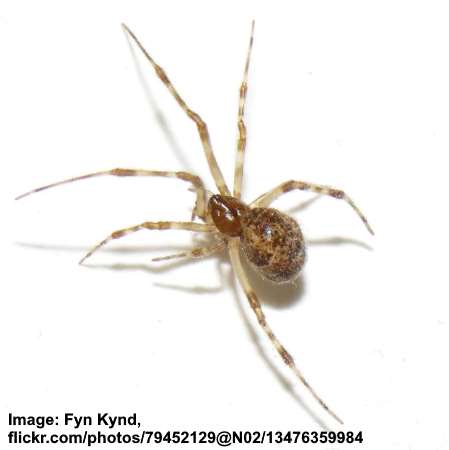
American house spider
American house spider (Parasteatoda tepidariorum)—The adult females are tan with dark brown markings and yellowish-brown legs. Common male house spiders are noticeably smaller than the females with less bulbous abdomen than females. These brown house spiders are also classed as cobweb spiders.
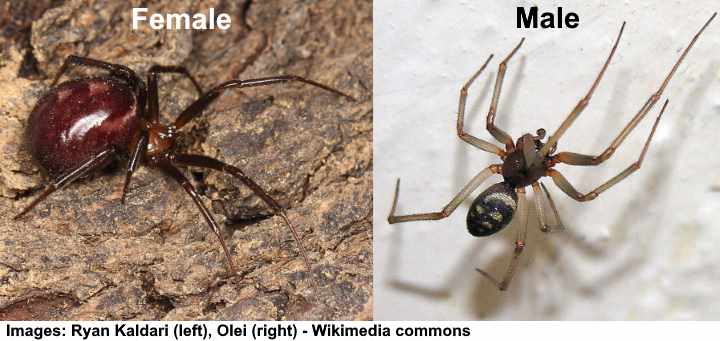
Cupboard spider: female (left) and male (right)
Cupboard spider (Steatoda grossa)—Also called the false black widow, this dark brown male house spider has light or white markings on its body. The females have a dark and more rounded body than the brown male spiders. Mature male cupboard spiders almost always have lighter coloured legs than the females.
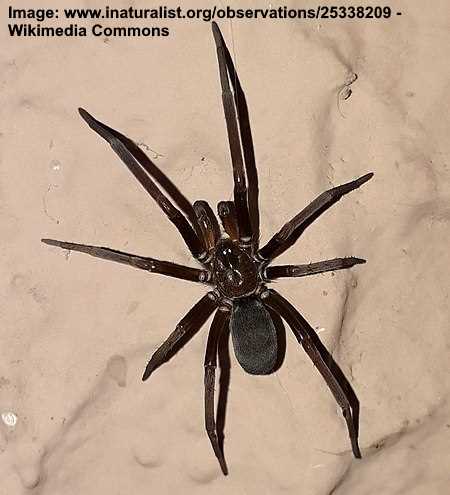
Southern house spider (Kukulcania hibernalis)
Southern house spider (Kukulcania hibernalis)—This brown spider is found in southern states like Florida and usually comes out at night. The southern house spider is often mistaken for a brown recluse, but it is larger with a more bulbous abdomen covered in fine hairs.
Brown Widow Spider (Latrodectus geometricus)
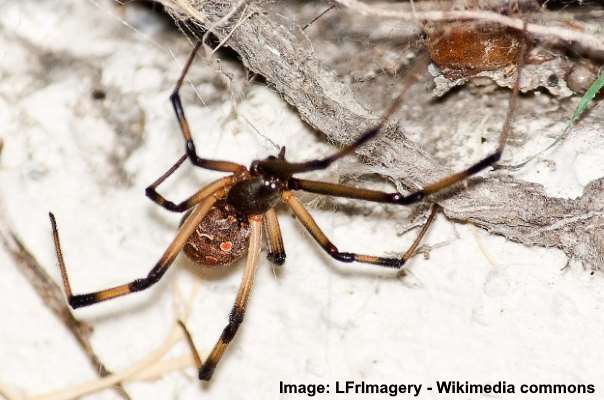
The brown widow spider is identified by its white and orange markings and brown and black banded legs
The brown widow spider is a tan-colored spider with white and orange markings. The identifying characteristics of this brown widow are its dark-brown cephalothorax, brown body with patterns, and long tan legs with black bands. Brown widows grow between 0.3” and 0.6” (8 – 16 mm) long.
Other names for the brown widow include brown button spider, brown-black widow spider, or geometric button spider.
A way to tell if you have brown widow spiders is by their egg sacs that look like cream-colored spiky balls.
Brown Spider Identification: To identify a brown widow spider, look for the hourglass-shaped marking, like black widow spiders, on its underside. Also, this brown spider has distinctive black stripes on yellowish-brown legs.
Giant House Spider (Eratigena atrica)
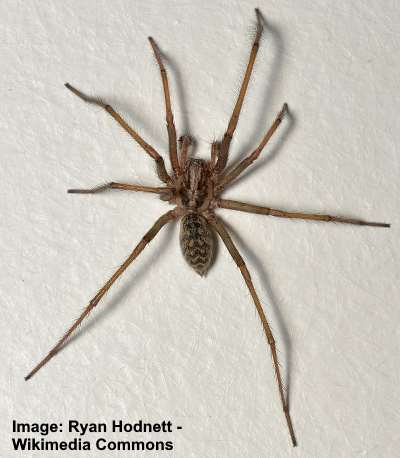
The giant house spider has a brown furry body with lighter markings and long legs
The giant house spider is a dark brown spider with light spots in an arrow shape on a furry abdomen pointing toward its head. This common spider species has long fuzzy legs that help to identify it apart from the domestic house spider.
This huge brown spider can grow up to 0.73” (18.5 mm) and has a leg span of 3” (75 mm). Up close, you’ll notice that the spider has characteristic eight eyes set in two rows.
Another identifying feature of the giant house spider is its large, messy funnel web. You’ll notice the webs in corners, behind cupboards, in basements, or attics.
Brown Spider Identification: The giant house spider is identified by its distinctive long furry legs and dark-brown hairy body with light markings.
Barn Funnel Weaver (Tegenaria domestica)
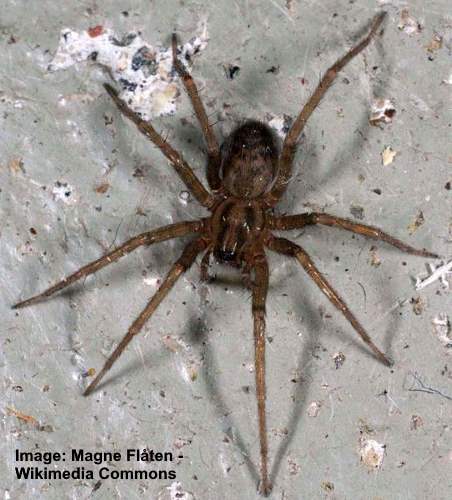
The barn funnel weaver has two black stripes on the front part of its brown body
The barn funnel weaver has a dark chocolate brown abdomen with faint stripes on brown legs. Also called the domestic house spider, adult females measure between 0.3” and 0.45” (7.5 – 11.5 mm). The spider gets its common name from the funnel webs it spins and its love of dark, undisturbed places.
Brown Spider Identification: The domestic house spider is identified by its brown and black patterns, flattened cephalothorax, and oval abdomen. The spider is dark brown and has striped legs.
Huntsman Spider (Heteropoda venatoria)

The huntsman spider (Heteropoda venatoria) has brown furry body with a huge leg span
The huntsman spider may look like a brown recluse spider, but it has a larger body and a huge leg span. The huntsman spider has a light brown, furry body and eight legs that look like a crab’s legs. A huntsman spider can measure up to 1” (25 mm) and a leg span of 4” (100 mm).
Apart from the difference in size, a way to tell a huntsman spider apart from a brown recluse is by its pairs of white and black spots on its thick, long furry legs.
Brown Spider Identification: To identify a huntsman spider, look for its light to dark brown flattened body, spiny brown legs, and two rows of four black eyes.
Wolf Spider (Lycosidae)

Wolf spiders have brown body with black stripes
The wolf spider is a brown spider with black stripes, a flattened head, and a round abdomen. A distinguishing feature of wolf spiders is their eyes. They have eight eyes, with two prominent eyes on the top row and six smaller ones underneath. Wolf spiders can grow between 0.4” and 1.4” (10 – 35 mm).
Some types of brown wolf spiders have white dots or white spots on their backs.
Brown Spider Identification: Wolf spider identification is by its distinctive black head with a brown stripe, brown abdomen with black patches, and long spiny legs.
Hobo Spider (Eratigena agrestis)
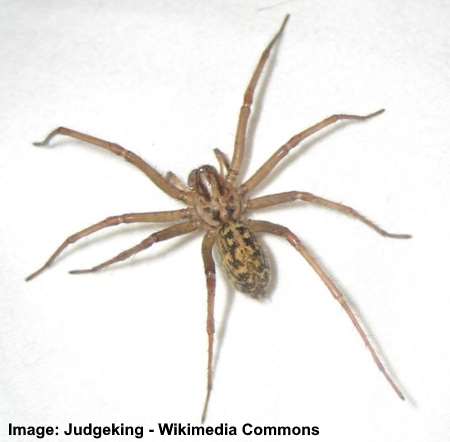
The hobo spider has light brown body with dark markings and long legs
The hobo spider looks like a wolf spider with its brownish color, blackish markings on the abdomen, and long straggly legs. However, compared to a wolf spider, a hobo spider has a smaller head and body. The light brown spiders grow up to 0.55” (14 mm) long.
One way to tell hobo spiders apart from other spiders in the family Agelenidae is the lack of colored bands on their light brown legs.
Brown Spider Identification: The hobo spider is identified as a brown spider with a dark brown abdomen and black and brown legs. There are also V-patterns on the middle of the abdomen and light stripes or spots.
Jumping Spider (Salticidae)
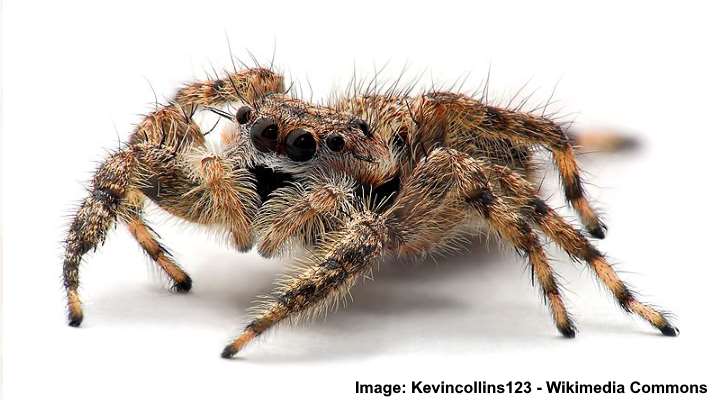
Jumping spiders have hairy brown body with black markings
A jumping spider with its brown fuzzy body with black markings looks like a brown tarantula or wolf spider. The distinguishing trait of the jumping spider is its eight eyes, with the central pair being particularly large. The black and brown spiders usually grow between 0.4” – 1” (10 – 2.5 mm) long.
This type of hunting spider moves relatively slow. However, it can jump reasonably high when in search of prey and hunting.
Brown Spider Identification: The recognizable feature of the tan jumping hairy spider is its fuzzy brown body with black spots.
American Grass Spider (Agelenopsis)
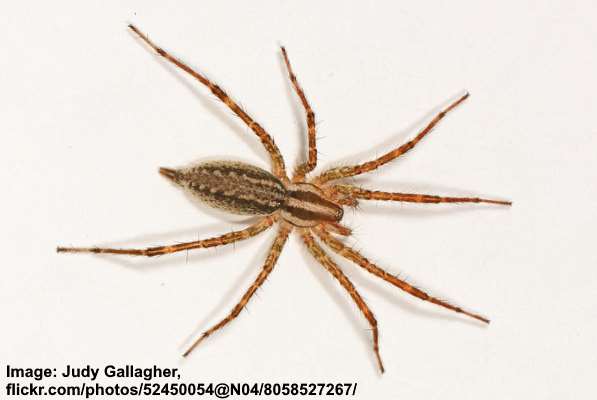
The American grass spider has a light brown body with dark brown stripes and brown patterns on its body
The American grass spider has a long tan body with dark brown stripes and light brown patterns. In addition, these funnel weaving spiders have orange-brown striped legs. The American grass spider is identified by its unique eye pattern—two eyes on the top and bottom rows and four in the middle.
Depending on the species, American grass spiders can grow up to 0.78” (20 mm). The species is known for their rapid movement as they scurry away from people or catch prey.
Brown Spider Identification: The identifying trait of the American grass spider is its two brown stripes on its light brown cephalothorax.
Nursery Web Spider (Pisauridae)
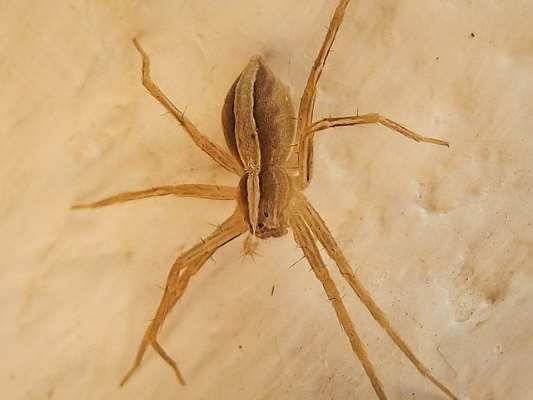
The nursery web spider has a light brown body with dark brown stripes and pointed end tail
The nursery web spider is a common house spider with dark brown stripes running down its light tan, cigar-shaped body. An identifying trait of the nursery web spider is the way it keeps its four front legs outstretched and close together. The adult females measure 0.5” to 0.9” (13 – 23 mm).
Brown Spider Identification: Nursery spiders are identified by their slender body that is wider at the cephalothorax and pointed at the tail end. Additionally, unlike wolf spiders, the nursery spider has eight eyes of the same size.
Parson Spider (Herpyllus ecclesiasticus)

The parson spider has dark brown body with white stripe on the back and reddish brown legs
The parson spider is a dark brown, almost black spider, with white striped markings on its back. Identifying features of a parson spider are its reddish-brown and black legs, dark brown body, and star-like appearance. Parson spiders measure 0.4” to 0.8” (10 – 20 mm) long.
The name, parson spider, comes from the shape of the spider’s body and legs. The dark brown and red spider looks like a type of cravat that was popular in the 18th century. You will find this venomous spider in homes or lurking under logs or rocks.
Brown Spider Identification: Parson spiders have black to brown bodies with a thick white band on slender abdomens.
Cellar Spider (Pholcidae)
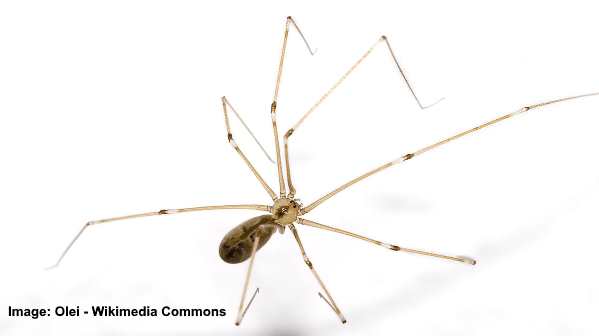
The cellar spider is commonly known as daddy-long-legs spider
A cellar spider has a tiny brown body and long spindly, light brown or yellowish legs. The peanut-shaped or globus body measures between 0.08” and 0.4” (2 – 10 m) long. However, its thin arching legs can be 2” (50 mm) long. Cellar spiders can have either six or eight eyes.
Other names for cellar spiders include daddy-long-legs spiders, vibrating spiders, skull spiders, or carpenter spiders. Signs of cellar spiders include messy webs in high corners, cellars, and attics.
Brown Spider Identification: Cellar spiders are identified by their small brown round abdomens and long slender legs.
Orb Weaver Spider (Araneidae)
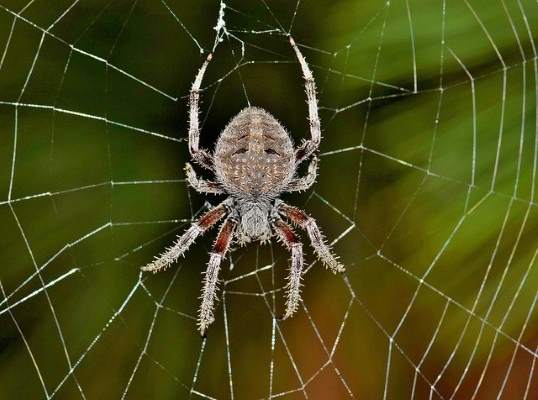
Orb weaver spiders include many species that vary in color and size
Some species of orb-weaver spiders have flattened, rounded brown bodies with black and white dots or spots. Orb weavers typically have spiny bodies and fuzzy legs. You can normally find orb weavers in gardens where they construct sticky wheel-like silk webs to catch their prey. Depending on the species, brown orb weavers can grow between 0.78” and 1.18” (20 – 30 mm).
Brown Spider Identification: The best way to identify orb-weaver spiders is by their circular webs, eight eyes, and spiny legs.
Woodlouse Spider (Dysdera crocata)
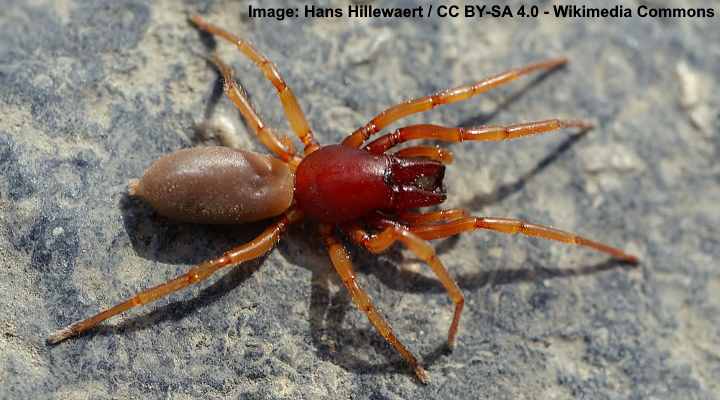
The reddish brown woodlouse spiders are usually found under logs but have also been found in houses
The woodlouse spider has a smooth orange-brown or dark red head, chocolate brown abdomen, and translucent reddish-brown legs. Woodlice spiders have a recognizable shiny brown appearance without dots or other distinguishing markings. Like the brown recluse spider, they have six eyes and measure 0.4” – 0.6” (11 – 15 mm).
The common name of the woodlouse spider comes from its dietary habits. The brownish-orange spider preys on pillbugs, slaters, woodlice, and sowbugs.
Brown Spider Identification: A woodlouse spider is identified by its orange, red, and brown body, shiny appearance, and six eyes in two rows—two on the top and four on the bottom.
Striped Fishing Spider (Dolomedes scriptus)

The striped fishing spider (Dolomedes scriptus) is commonly found in houses near a lake or a river
The striped fishing spider is a large brown spider with white bands along its head and abdomen and light brown and black patterns on its back. Pictures of the brown spider show it has identifiable light bands around its spiny brown legs. The body of adult females can be up to 1” (25 mm) long with a leg span of 2.3” (60 mm).
The dark fishing spider lives near water. These biting spiders tend to be timid and avoid people; however, if they do bite, the effect is no more severe than a bee sting.
You may discover striped fishing spiders in your house if you live near a lake or river.
Brown Spider Identification: The large striped brown fishing spider has indistinctive light brown and black patterns on its back, a light stripe along its abdomen and cephalothorax, and banded brown legs with black dots.
Learn how to identify many other types of spiders.
Related articles:
- The Most Common House Spiders
- Small House Bugs – Identification Guide
- Types of Beetles – Identification Guide
